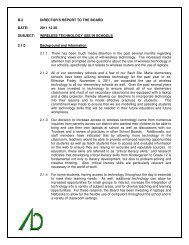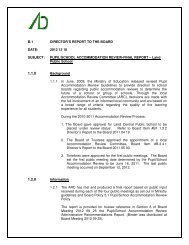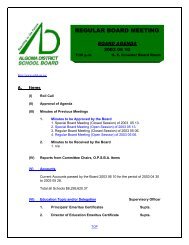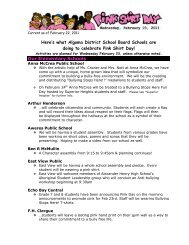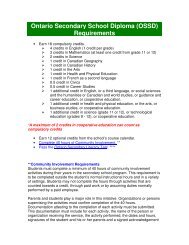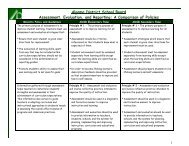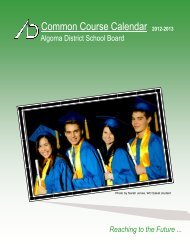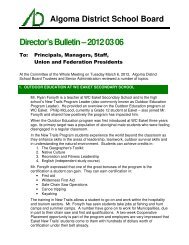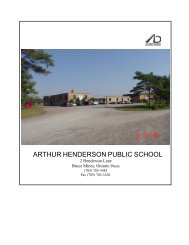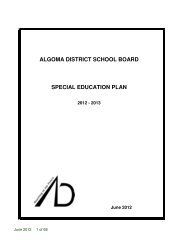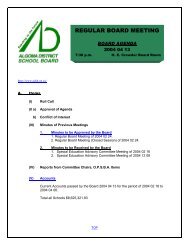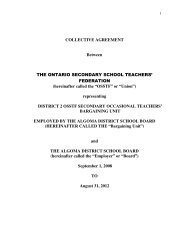Educating Our Educators (March 2011) - Algoma District School Board
Educating Our Educators (March 2011) - Algoma District School Board
Educating Our Educators (March 2011) - Algoma District School Board
- No tags were found...
Create successful ePaper yourself
Turn your PDF publications into a flip-book with our unique Google optimized e-Paper software.
Appendix iThis procedure/protocol supports the <strong>Algoma</strong> <strong>District</strong> <strong>School</strong> <strong>Board</strong>’s Safe <strong>School</strong>s Policyand Code of Conduct - specifically 6 6.49 (2.1) respect and treat others fairly, regardless of,for example, race, ancestry, place of origin, colour, ethnic origin, citizenship, religion, gender,sexual orientation, age, or disability___________________________________________________________________ADSBSmudging Procedure/ProtocolThe <strong>Algoma</strong> <strong>District</strong> <strong>School</strong> <strong>Board</strong> recognizes and supports the cultural practices associatedwith the various heritages represented by the students and staff within its organization.These practices include cultural and educational events, meetings and relevant classroompresentations, being sensitive not to impinge on the rights of other.The Anishinaabe way of smudging with any of the four traditional medicines as part ofcultural ceremony is supported within all ADSB’s facilities.As outlined in the “Smoke Free Ontario Act ’ policy and the <strong>Algoma</strong> Public Health policy anexception has been noted: “…..accommodate the use of tobacco or related substances inconnection with culturally significant celebrations formally conducted on campus bymembers of the Anishinaabe community.”1. The four sacred medicines include: tobacco, sage, sweet grass and cedar. Themedicines and other sacred items associated with Anishinaabe practices from allAnishinaabe cultures are also included.2. Students, staff and Elders are free to use tobacco or related items to conductindividual or group traditional practices such as Opening/Closing prayers, Smudging,Feasts, Sacred Circle Ceremonies, Pipe Ceremonies, Sweat/Moon Lodge Ceremonies,Pow Wows, Anishinaabe drumming/ singing, etc.3. Responsibility for the safe and appropriate use of the smudging ceremony rests onthe users and participants. Where at all possible smudging is to take place outdoors.Barring that, every precaution is to be made to continue to respect the needs of others notparticipating (i.e. smoke, inhalants, lingering odour). Smudging must use the minimalamount of sacred medicine in order to satisfy ceremonial requirements while minimizing thepotential impact on the learning environment and on the health and wellbeing of students,staff and visitors.4. <strong>School</strong> Administration will direct the timing and place of any smudging.5. Any student staff or visitor affected by exposure to smoke should contactAdministration as soon as these effects are felt. Administration is expected to act with duediligence.<strong>Educating</strong> <strong>Our</strong> <strong>Educators</strong> – <strong>Educating</strong> <strong>Our</strong> Aboriginal Students for Success 91



